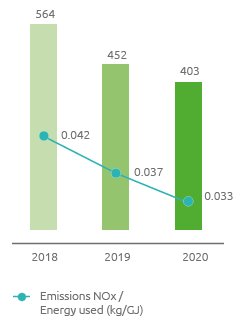Nitrogen oxide emissions (NOx)
Total NOx emissions (t)

In terms of pollution, the use of natural gas as the main energy source is less impactful than diesel or gasoline, and significantly reduces emissions of sulphur oxides and particulate. Consequently, the only emissions that are relevant are those relating to nitrogen oxides (NOx), which for Snam derive mainly from the combustion of natural gas in the turbines of the compression plants and which were 3.7 and 3.8 [mg/Nm3]/MW respectively for the storage and boosting of gas in the reservoirs.
In order to contain NOx emissions, Snam has launched a programme over the years to replace traditional turbines with low-emission turbines (DLE) which, to date, account for almost all of those installed for the Group and 100% of those present at the storage sites. All these initiatives together have led to a reduction in total NOx emissions of 11% compared to 2019 (from 452 to 403 tonnes) and a reduction in the ratio of nitrogen oxide emissions to energy used of 11%.
Emissions of NOx in the atmosphere were calculated based on direct measurements or, if not available, by means of emission factors present in the literature (EMEP/EEA “Air pollutant emission inventory guidebook” European Environment Agency).